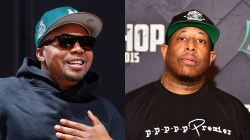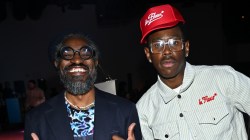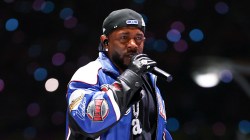In 2002, the often innovative Nasir Jones showed Hip Hop fans the could-have-been verses from his composition tablets in “Book Of Rhymes.” Listeners rejoiced at glimpses of the thoughts and styles the Queens emcee was toying with, and likely questioned why they remained dusty until Alchemist reportedly suggested the memorable concept. Another pillar in Hip Hop, that’s often left under-covered in the mainstream media is graffiti. The oldest of Hip Hop’s four elements draws a close similarity to the rhyme-book in the age-old piecebook.
Released just two months ago, Piecebook Reloaded: Rare Graffiti Drawings 1985-2005 is a gimpse at the personal, visual journal entries from some of the medium’s top writers. Compiled and edited by longtime Source “Graf Flix” columnist and cultural ambassador David Villorente and Hip Hop author, ego trip–co-founder and editor Sacha Jenkins. Both accomplished artists, the two spoke to HipHopDX about piecebooks, compiling their second in a trilogy of these books, and why old rivalries, like old habits, die hard.
HipHopDX: In a nutshell, how would you explain a piecebook to somebody who knew very little about graffiti to begin with?
David Villorente: Piecebooks are…how do I explain them? It’s kind of a staple in graffiti culture. When you first start writing graffiti, you purchase a piecebook. You practice your outlines in them. You fine-tune your skills in them. And then you pass your book around to the artists whom you respect or admire. It’s no different than an autograph book. When you’re graduating, senior year, all the students pass their [yearbooks] around to fellow students. It’s the same. You pass your piecebook around to all the fellow graffiti dudes that you respect.
DX: A lot of these writers were and are a part of various crews and whatnot. But is that sense of “passing” what allows writers to collaborate and work together?
David Villorente: You can start your outlines in the book and translate… a lot of the work that ends up on the sides of trains or used to end up on the sides of trains or handball courts probably started in someone’s blackbook. Typically, you passed them around to the guys you’re cool with. As you meet more writers, it’s kind of like a testament to who you’ve met. So if I show up to Sacha’s house with my blackbook, I can show him that I actually met T KID. This was during an era where graffiti wasn’t so much at the forefront. It was still very much underground movement during the times that blackbooks originated. Graffiti writers didn’t have [showcases and exhibits]. Dudes were kind of clandestine; it was this underground community of dudes. If I said I met Stay High 149, you might not believe me. But if I showed you his signature in my book, it became very real. It represented a ton of things: it was your journal, it was your sketchbook, it’s where ideas began, beefs might’ve got started in books. There was a social nature to the books. They made their rounds; you could pass a book to somebody and potentially not see that book for another two or three years. I’ve reunited people with books – 20 years later, true story.
DX: My context for the culture of graffiti is limited. I read a lot of the books that come out, but your introduction really helped me – namely with the quote, “There’s nothing more honest than a drawing not intended for the world to see.” In compiling this book, what are some of those honest moments and big things that you really recognized in the art that’s available here?
David Villorente: There’s a bunch of things. The Jon 156 journal entry. It was on a piece of spiral, loose-leaf paper that was inserted in the book. Jon starts talking about the trip to Harlem, and how different it was. They’re like these teenage revelations and experiences that he’s kind of capturing. At the time, Jon 156 was just some Dominican kid from Washington Heights. Now he’s this established, fine artist who lives in Paris and does shows in Hong Kong and around the world. Him discovering Harlem and comparing the differences between Harlem and his Washington Heights community, I don’t think that’s something that he ever intended the world to see. I don’t think that when he wrote that, the world who have any idea who Jon was, in 2009, and that he’d be this relevant important artist.
Sacha Jenkins: That’s the thing about the books: we did our first book [Piecebook: The Secret Drawings Of Graffiti Writers, 2008], which spans 1973 to 1985. Piecebook Reloaded kind of picks up the baton, where we left off. No one was really thinking about galleries. When these illustrations were being made…art is very emotional. Your emotions dictate the output. Some days are better than others. Some days an artist is really inspired, and you can see that influence and inspiration and detail that was put into the book. That piece was crafted just for a friend. Maybe 30 people over X amount of years would see this super-masterful piece, or something stripped down, that’ll mean something to someone in the culture when they see it. Someone in the culture will know, “Oh, they just rattled that off,” or “Oh, that’s a throwup.” For those who understand the culture and understand where it all comes from, the different levels of complexity – whether it be a signature or something that’s full-color, that all says something to the people who are familar with the culture. For those who aren’t familiar with the culture, it’s definitely a very personal view at the minds of very young people. These are kids who aren’t pretentious. They aren’t in it to make money or get into the art world, they just wanted recognition from their peers. That’s what we wanted to do [with the book]. For anybody else that wants to see what the culture has to offer, all we can do is say welcome.
DX: That’s a great point. As this is the second volume, looking at the medium of the piecebook, how would you say it evolved?
David Villorente: I think with the earlier stuff, that appears the first edition of Piecebook, some of the stuff…I wouldn’t say it was dated, but there were guys pioneering and developing styles. With the new book, it’s an example of how graffiti has evolved. There’s some amazing illustrations in the first book, but in the second book, the level of detail in the art becomes a little more polished. The complexity of the designs, for instance, it’s clear that there were some dudes raised on Marvel and the Jack Kirby-esque style of illustration, with the STEM piece in particular. We were talking about Marvel the other day, when he was picking up his copy of the book, and he told me what a huge influence Jack Kirby had on his artwork. It’s evident. [Another evolution is] the scale of the artwork. There are more two-page-fold spreads that are far more colorful than the first book. You can see the progression of graffiti through the two books. It’s funny too, whenever I hand somebody the book, they land on the two-page spreads, and the most colorful spreads in the book.
DX: It’s funny you say that. I had some folks over for Monday Night Football. The book is on my coffee table, and the two-page spreads are exactly where the skimmers go. On top of that, the backs of the pages are interesting. We see the reverse, and these amazing saturated, color splotches that are art in their own right. It might be a silly question, but how intentional was that to keep in the book, and can you speak on the significance?
Sacha Jenkins: With the first book, that’s something that we didn’t do. The reaction to the first book was, “Wow, this is so authentic. It looks like a real book.” Dave was in situations where he ran into some friends who were writers, and they’d be like, “Wow, where did you get this book? Who’s book is this?” And he’d say, “Well, it’s my book, but it’s not my book. It’s my book, as in the book I produced.” It threw a lot people off because they were really impressed with the authenticity. We wanted to make improvements though. We wanted to make it a little bit more inclusive, while keeping it true to the core. In the first book, my Foreward was handwritten by a writer, SP ONE a/k/a Greg Lamarche. He has an amazing hand-style. The Foreward I wrote this time is in typeface so more people can appreciate it on a much simpler level. We also added these thumbnails at the back of the book to make it easier for people to see who the artists are and what it actually says. In terms of the bleed-throughs, it definitely sacrifices the amount of art. But at the same time, the response has been overwhelming in terms of people actually appreciating the detail and really making people like it’s an actual, authentic book. We were also mindful, with the first book and this one, to have some blank pages. So people have the opportunity to add their art to the book.
DX: Tell me about the process of compiling these… What was anybody reluctant about putting this stuff out there?
Sacha Jenkins: The idea was to get as many books as possible. Then me and Dave would sit down and discuss what would tell the best possible story. It wasn’t always about getting the best of someone, it was really about getting the best of what’s gonna help tell the overall story. We were striving for that balance.
David Villorente: At some point, it’s safe for me to say that I probably had about 50 or 60 piecebooks from various artists sitting in my livingroom while we were working on the book. It’s a unique situation. For these guys, a lot of these books have been in their possession anywhere from the past 30 to 15 years or whatever it might have been. Some of these books never left their possession. They just sat on their bookshelves, some of this amazing art, like, “I’ll pass this to my kid one day.” A, the trust that they instilled in us, loaning us these books was tremendous. This amazing art, we’d flag it, Sacha and I. I like this, he likes that, we’d meet in the middle. Then we’d approach the artists. Strangely enough, what I found most interesting was that a lot of the artists we’d meet were their own worst critics. “Know what? I actually hate that piece.” We’d be like, “Come on dude. We both love that piece.” After a little bit of compromise… I heard this from more than one artist: “No matter what you picked from the book, I probably would have told you I hated it anyway, so just run with [whatever you want].” In the end, it was something that they were happy with. Based on the success of the first book, collecting stuff for the second book became so much easier. There were a handful of people that were skeptical or curious about what we were gonna do with these books.
One thing that’s very interesting about the graffiti community is that these rivalries that these artists have with their contemporaries don’t die when they stop writing graffiti. That guy who you were competing with in 1980 is still in your head. He’s still your rival. [Hypothetically], I go to Sacha and tell him about the book and ask him to be in it. He doesn’t want to [submit anything]. Then I tell him all about who’s in the book – [listing all these great graffiti writers]. Suddenly, you strike a nerve. There’s this name that was mentioned that he still feels like he’s competing with. Suddenly, somebody who was adamant about not giving you anything has gone home and torn up his apartment and given you three books that he had in storage. “Use what you need.” To me, I find it very interesting how competitive, at the root, most of these artists still are.
DX: My final question. Recently, Revok was arrested while leaving Australia for tweeting his whereabouts. I don’t mean to tokenize either of you in asking, but as graffiti enthusiasts and experts, can I get a reaction to that?
David Villorente: I can tell you this much: old habits die hard. That’s what we do as graffiti artists. We go places and write on things. That’s why the world is fascinated with us. He was simply doing what he does. Unfortunately, he was sharing his business on Twitter, and they were able to arrest him at the airport. Revok is a super-talented dude, he’s a good guy. Unfortunately, he got caught up in the game. It’s a very interesting thing: you bring graffiti artists places, they’re probably gonna write on stuff. That’s exactly what they do. It’s like inviting the vampire to your home. You expect it. You can’t be too mad at it. I wish the dude good luck with whatever legal charges he may have pending.
Sacha Jenkins: I heard something. I’m not sure what happened, but I know he’s from the west coast and he’s in MSK and AWR, some of the most-respected crews in the world. Out of all those dudes, I’m just a huge fan of his stuff. I’ve met him a couple times. He’s a nice guy. Graffiti is an international language with its own regional dialects. With ambassador who travel the world and converse with the locals. I guess he was parlaying over there and they tried to treat him like kangaroo meat, which isn’t cool. I think it says that people are really intimidated by it. With the advent of the Internet, let’s look at the positives. As a grown-ass man, I understand that yo, I don’t want people writing on my property. At the same time, so many young people are sitting on their ass, playing video games and being online or texting each other. This culture is about going out, making a name for yourself, interacting with people. That’s something that’s on the decline in our society. I might sound like a cornball saying all that shit, but if people actually thought about how to treat what they consider to be a problem, I’m sure they can find a solution that can benefit anybody. Real writers don’t give a fuck, and they’re gonna go out and do what they’ve gotta do anyway. To them, I say be careful. To everybody else, I say mazal tov.
Purchase Piecebook and Piecebook Reloaded here.



![Method Man Admits He Didn't Like Drake's "Wu-Tang Forever": "I [Wasn't] Getting On That"](https://hiphopdx.com/wp-content/uploads/2025/12/method-man-drake-wu-tang-forever-remix.jpg?w=250)






Definitely one of the best interviews, in my opinion. Kept me interested the whole way through. Too bad for me I am a little late on the discovery of such a dope article….. better late than never I suppose ;0(